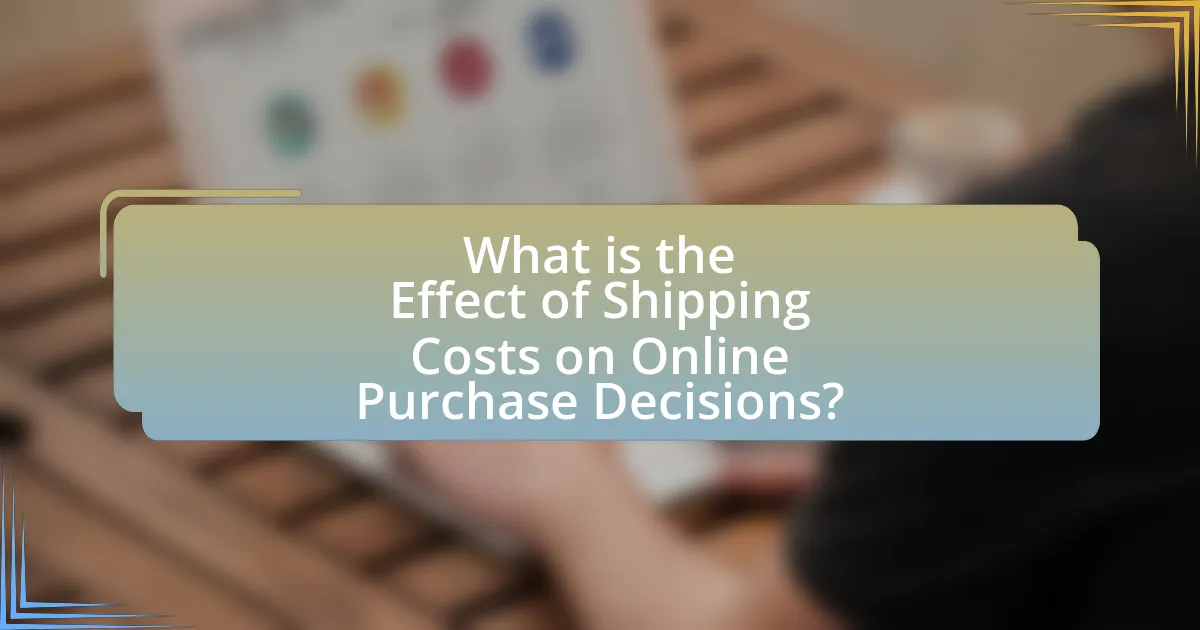Shipping costs are a critical factor influencing online purchase decisions, often leading to cart abandonment when fees are perceived as excessive. Research indicates that a significant percentage of consumers, particularly younger demographics, prioritize free shipping options, with many abandoning their carts due to unexpected shipping costs. The article explores how shipping fees affect consumer behavior, satisfaction, and loyalty, highlighting the importance of transparent pricing and effective shipping strategies for retailers. Additionally, it discusses emerging trends in e-commerce, such as the growing demand for free shipping and the adaptation of retailers’ shipping strategies to meet consumer expectations.

What is the Effect of Shipping Costs on Online Purchase Decisions?
Shipping costs significantly influence online purchase decisions, often acting as a deterrent for consumers. Research indicates that high shipping fees can lead to cart abandonment, with studies showing that 60-80% of online shoppers abandon their carts due to unexpected shipping costs. Additionally, a survey by the National Retail Federation found that 75% of consumers consider free shipping a key factor in their purchasing decisions. Thus, the presence of high shipping costs can directly reduce conversion rates and overall sales for online retailers.
How do shipping costs influence consumer behavior in online shopping?
Shipping costs significantly influence consumer behavior in online shopping by affecting purchase decisions and overall satisfaction. High shipping fees often lead to cart abandonment, as consumers may perceive the total cost as too high compared to their expectations or budget. According to a study by the Baymard Institute, approximately 69.57% of online shoppers abandon their carts, with high shipping costs being a primary reason cited by 44% of respondents. Additionally, free shipping options can enhance consumer willingness to complete a purchase, as 93% of consumers are more likely to shop again from a retailer that offers free shipping. Thus, shipping costs directly impact both the likelihood of completing a transaction and the overall customer experience in online shopping.
What psychological factors are affected by shipping costs?
Shipping costs significantly affect psychological factors such as perceived value, purchase intention, and buyer anxiety. When consumers encounter high shipping fees, they often perceive the overall value of the product as diminished, leading to a decrease in their willingness to complete the purchase. Research indicates that 61% of online shoppers abandon their carts due to unexpected shipping costs, highlighting the impact on purchase intention. Additionally, high shipping costs can induce buyer anxiety, as consumers may feel uncertain about the fairness of the total price, which can deter them from finalizing their transactions.
How do shipping costs compare to product prices in consumer decision-making?
Shipping costs significantly influence consumer decision-making, often impacting the perceived value of a product. Research indicates that high shipping fees can deter consumers from completing purchases, as they may view these costs as an additional expense that diminishes the attractiveness of the product price. For instance, a study by the Baymard Institute found that 49% of online shoppers abandon their carts due to unexpected shipping costs, highlighting the critical role shipping fees play in the overall purchasing decision. This demonstrates that consumers frequently weigh shipping costs alongside product prices, leading to a preference for retailers that offer transparent or free shipping options.
Why are shipping costs a critical factor in e-commerce?
Shipping costs are a critical factor in e-commerce because they directly influence consumer purchasing decisions. High shipping costs can deter customers from completing their purchases, as evidenced by a study from the Baymard Institute, which found that 49% of online shoppers abandon their carts due to unexpected shipping fees. Additionally, competitive shipping rates can enhance customer satisfaction and loyalty, as consumers often compare total costs, including shipping, across different retailers. Thus, managing shipping costs effectively is essential for maximizing sales and maintaining a competitive edge in the e-commerce market.
What role do shipping costs play in the overall shopping experience?
Shipping costs significantly influence the overall shopping experience by affecting consumer purchasing decisions and satisfaction levels. High shipping costs can deter customers from completing their purchases, as studies indicate that 58% of online shoppers abandon their carts due to unexpected shipping fees. Conversely, transparent and reasonable shipping costs can enhance customer trust and encourage repeat purchases, as 93% of consumers consider shipping costs when evaluating their overall shopping experience. Thus, shipping costs play a critical role in shaping consumer behavior and satisfaction in online shopping.
How do shipping costs affect customer satisfaction and loyalty?
Shipping costs significantly impact customer satisfaction and loyalty by influencing the overall perception of value in online purchases. High shipping fees can lead to dissatisfaction, as customers often expect reasonable or free shipping options; a study by the National Retail Federation found that 75% of consumers consider free shipping a key factor in their purchasing decisions. Additionally, when shipping costs are perceived as excessive, customers are more likely to abandon their carts, which directly affects brand loyalty. Research from the Baymard Institute indicates that 49% of online shoppers cite high shipping costs as a primary reason for cart abandonment. Therefore, businesses that manage shipping costs effectively can enhance customer satisfaction and foster long-term loyalty.
What trends are emerging regarding shipping costs in online retail?
Emerging trends regarding shipping costs in online retail indicate a significant shift towards free shipping options and increased transparency in shipping fees. Many retailers are adopting free shipping thresholds, where customers receive free shipping on orders above a certain amount, as a strategy to boost average order values. According to a 2023 survey by the National Retail Federation, 75% of consumers expect free shipping on online orders, reflecting a growing demand for cost-effective delivery solutions. Additionally, retailers are increasingly providing clear breakdowns of shipping costs at checkout to enhance customer trust and reduce cart abandonment rates. This trend aligns with findings from a 2022 study published in the Journal of Business Research, which revealed that transparent shipping costs positively influence consumer purchase intentions.
How are retailers adapting their shipping strategies to meet consumer expectations?
Retailers are adapting their shipping strategies by offering faster delivery options and free shipping thresholds to meet consumer expectations. For instance, many retailers have implemented same-day or next-day delivery services, responding to the growing demand for quick fulfillment. According to a 2022 survey by the National Retail Federation, 75% of consumers expect free shipping on orders over a certain amount, prompting retailers to set minimum purchase requirements to qualify for free shipping. Additionally, retailers are utilizing advanced logistics technologies and partnerships with third-party delivery services to enhance efficiency and reduce shipping costs, thereby improving customer satisfaction and retention.
What impact do free shipping offers have on purchase decisions?
Free shipping offers significantly increase purchase decisions among consumers. Research indicates that 93% of online shoppers are more likely to complete a purchase if free shipping is available, as it reduces the perceived total cost of the transaction. Additionally, a study by the National Retail Federation found that 75% of consumers expect free shipping on orders over a certain amount, demonstrating that free shipping not only influences immediate purchases but also affects the overall shopping behavior and expectations of consumers.
How do different demographics respond to shipping costs?
Different demographics respond to shipping costs in varied ways, significantly influencing their online purchase decisions. For instance, younger consumers, particularly millennials and Gen Z, tend to prioritize free shipping options and are more likely to abandon their carts if shipping costs are perceived as too high. In contrast, older demographics, such as baby boomers, may be more tolerant of shipping fees if they perceive the value of the product as high. Research by the National Retail Federation indicates that 75% of consumers consider shipping costs a critical factor in their purchasing decisions, with younger shoppers being more sensitive to these costs. Additionally, income levels also play a role; lower-income consumers are generally more affected by shipping fees, often leading to cart abandonment when faced with additional costs.
What variations exist in shipping cost sensitivity among different age groups?
Shipping cost sensitivity varies significantly among different age groups, with younger consumers generally being more price-sensitive than older consumers. Research indicates that millennials and Gen Z shoppers are more likely to abandon their carts due to high shipping costs, with studies showing that 61% of millennials consider shipping fees a critical factor in their purchasing decisions. In contrast, older generations, such as baby boomers, tend to prioritize reliability and service over shipping costs, often being less deterred by additional fees. This difference in sensitivity can be attributed to varying financial priorities and shopping behaviors across age demographics, as younger consumers often have tighter budgets and a greater emphasis on value.
How do income levels influence perceptions of shipping costs?
Income levels significantly influence perceptions of shipping costs, as individuals with higher incomes tend to view shipping fees as a minor expense compared to their overall purchasing power. Research indicates that consumers with lower income levels often perceive shipping costs as a substantial barrier to purchase, leading to increased price sensitivity. For instance, a study by the National Retail Federation found that 60% of low-income shoppers consider shipping costs a critical factor in their buying decisions, while only 30% of high-income shoppers share this concern. This disparity highlights how income levels shape the perceived value of shipping, affecting overall online purchase behavior.
What are the implications of shipping costs on pricing strategies?
Shipping costs significantly influence pricing strategies by directly affecting the final price consumers pay for products. Businesses often incorporate shipping costs into their pricing models to maintain competitiveness and profitability. For instance, a study by the National Retail Federation found that 75% of consumers expect free shipping on orders over a certain amount, prompting retailers to adjust their pricing to accommodate these expectations. This adjustment can lead to strategies such as increasing product prices slightly to cover shipping or offering free shipping thresholds to encourage larger purchases. Thus, shipping costs not only impact the pricing structure but also shape consumer behavior and purchasing decisions.
How can businesses balance shipping costs with competitive pricing?
Businesses can balance shipping costs with competitive pricing by implementing strategies such as offering free shipping thresholds, optimizing shipping methods, and utilizing technology for cost analysis. For instance, setting a minimum purchase amount for free shipping encourages larger orders, which can offset shipping expenses. According to a study by the National Retail Federation, 75% of consumers expect free shipping on orders over a certain amount, indicating that this strategy can enhance competitiveness. Additionally, businesses can negotiate rates with carriers or use fulfillment centers to reduce shipping costs, allowing them to maintain lower prices while still covering expenses. By leveraging data analytics, companies can identify the most cost-effective shipping options and adjust pricing strategies accordingly, ensuring they remain attractive to consumers while managing shipping costs effectively.
What pricing models are most effective in mitigating shipping cost concerns?
Dynamic pricing models are most effective in mitigating shipping cost concerns. These models adjust shipping fees based on real-time factors such as demand, distance, and delivery speed, allowing businesses to optimize costs and offer competitive rates. For instance, a study by the Journal of Business Research found that dynamic pricing can lead to a 15% reduction in shipping costs by aligning prices with market conditions. Additionally, subscription-based pricing models, where customers pay a flat fee for unlimited shipping, have proven successful in increasing customer loyalty and reducing perceived shipping costs, as evidenced by Amazon Prime’s significant growth in membership and sales.
What best practices can retailers implement to address shipping cost issues?
Retailers can implement several best practices to address shipping cost issues, including optimizing shipping methods, offering free shipping thresholds, and utilizing regional fulfillment centers. Optimizing shipping methods involves selecting carriers that provide the best rates and delivery times, which can significantly reduce costs. Offering free shipping on orders above a certain amount encourages customers to increase their cart size, effectively distributing shipping costs across larger purchases. Utilizing regional fulfillment centers allows retailers to store inventory closer to customers, minimizing shipping distances and costs. According to a study by the National Retail Federation, 75% of consumers expect free shipping on orders over a certain amount, highlighting the importance of these practices in influencing purchase decisions.
How can retailers effectively communicate shipping costs to consumers?
Retailers can effectively communicate shipping costs to consumers by providing clear, upfront information on shipping fees during the checkout process. Transparency in shipping costs helps reduce cart abandonment, as studies indicate that 44% of online shoppers abandon their carts due to unexpected shipping fees. Retailers should display shipping costs early in the shopping experience, ideally on product pages, and offer multiple shipping options to cater to different consumer preferences. Additionally, utilizing visual aids, such as shipping cost calculators or banners, can enhance understanding. By implementing these strategies, retailers can foster trust and improve the overall shopping experience, ultimately influencing purchase decisions positively.
What strategies can enhance customer perception of shipping value?
To enhance customer perception of shipping value, businesses can implement transparent pricing, offer free shipping thresholds, and provide real-time tracking updates. Transparent pricing eliminates hidden fees, fostering trust and reducing cart abandonment; studies show that 61% of consumers abandon their carts due to unexpected shipping costs. Offering free shipping on orders above a certain amount encourages larger purchases, as 93% of consumers are motivated to buy more to qualify for free shipping. Real-time tracking updates improve customer satisfaction by keeping them informed about their order status, which can lead to a 20% increase in repeat purchases.





